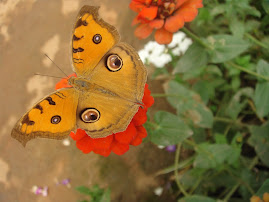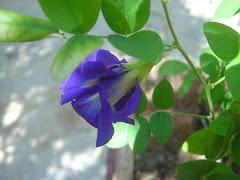
One of the most popular flowering shrubs seen in home gardens and parks
is the Mussaenda/
Mussaenda erythophylla. The usual colours seen here,
are this peachy pink that I have (Dona Luz), white (Dona Aurora), a lighter
shade of pink (Queen Sirikit), and red (Dona Evangelina).
It's a shrub that can grow to over 10 feet in height and blooms throughout
summer. It is for this intense colour that this ornamental shrub has a
focal place in most gardens.

Mine is growing in a large er..plastic bucket. Earlier ones planted on
the ground could not bear the brunt of excess water during the rains.
I learnt the hard and rather expensive way that it loves a well-drained
soil and in my garden, that's easiest to come by...in a container!! But
now it seems happy and has already given me several months of peachy
colour. It's just that I had included it for a GBBD post, and I didn't
want to post the same again so soon.
A native of Asia (some websites mention Africa), the Mussaenda belongs
to the coffee family, Rubiaceae. Out of the cultivars I'd mentioned earlier,
'Queen Sirikit' is the only one named after the Thai queen. The other
cultivars are named after the First Ladies of the Philippines.
This shrub does well in high humidity and hot weather conditions. Propaga-
tion is by cutting or air layering. It does not require much feeding.
Watering should be moderate but the soil should remain moist. The shrub
can be pruned during winter when there's hardly any colour left on it.


The tiny blooms surrounded by colourful sepals remind me of....

...the blooms of the Bougainvillea.

See how pale some of the sepals are now. Gradually, all that bright peach
will turn pale and fall off.

Not satisfied with just the photos of my potted plant, I head off to
the gardens of Srimanta Sankardev Kalakshetra, a cultural centre
housing museums, an amphitheatre, a children's park and much more.
But I simply scouted around for Mussaenda!!! And these are what I
saw!

Bamboo support is used for these tall shrubs. All those blooms must
be so heavy that they need to be propped up like that!


And on a roundabout closer home, the white variety grows next to
dark pink Pentas. I thought the pink and white combination looked
pretty. What do you think?








































































